In January, 2021, Loyola University Chicago Stritch School of Medicine, the first U.S. medical school to offer the Transcendental Meditation program as an elective, invited Tony Nader, M.D., Ph.D., M.A.R.R., head of the international TM organizations, to speak to students and faculty. Dr. Nader is a medical doctor trained at Harvard University, with a Ph.D. in neuroscience from Massachusetts Institute of Technology.
Dr. Nader spoke at Psychiatry Grand Rounds on January 21, via teleconference, about the effectiveness of the TM technique to dissolve stress and improve health.
Watch Dr. Nader’s talk at Psychiatry Grand Rounds (1:02:31)
On January 27, Dr. Nader spoke by teleconference to MDED 400: Physician Wellness through the Transcendental Meditation Technique, an elective that has been offered at Stritch since 2014. In this lively Q&A, he answers future physicians’ questions about the TM technique:
- How is the easy, effortless practice of TM rewarding for seasoned practitioners?
- How does the TM technique differ from other forms of meditation?
- How should we respond to questions about TM and religion?
- Would implementing the TM technique within a medical residency program be beneficial?
- What changes in ourselves can we expect as we continue our practice of TM?
- Could the TM program be implemented on a large scale for patients with cardiovascular risk factors, to prevent progression of their disease?
- What are the practical benefits for medical professionals of practicing the TM technique over many years?
- How can we reconcile modern Western medicine and traditional forms of healthcare, and where does meditation fit in?
The following sections summarize Dr. Nader’s answers, to serve as a resource and guide to his Q&A with students at Chicago Stritch School of Medicine.
Watch Dr. Nader’s Q&A with medical students (55:27)
How is TM an easy and effortless practice while at the same being a practice that offers a richer, more rewarding experience for more seasoned practitioners?
Achievements usually require activity and dynamism. Our plans have to be fulfilled through action to bring achievements and fulfillment. But our actions have their basis at a more fundamental level, which is our thinking mind. The thought process is the way we bring our plans to fruition.
Depending on the level of stress within our mind and body, our thoughts can be influenced by prejudice, fear, confusion, and other factors that cloud our awareness. For the most effective and successful implementation of our desires and plans, therefore, clarity of thinking is vitally important.
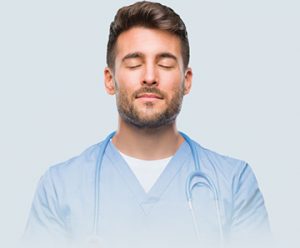
The TM technique enhances coherent brain functioning
The Transcendental Meditation technique opens up the reserves of the brain and enhances the coherent functioning of different parts of the brain, which leads to greater clarity of thinking and effectiveness of action. This change doesn’t happen because of any outer effort on our part, but instead is due to going back to the Self, our inner value, the fullness of who we are, and dissolving the stresses that cloud our full appreciation of life.
With regular TM practice, this expanded state of awareness becomes a permanent feature of life, in which the Self is not lost even in the midst of dynamic activity. This is the state of enlightenment, the realization of full human potential, which gives us access to the full reservoir of power and intelligence within us.
The TM technique opens up the reserves of the brain and enhances the coherent functioning of different parts of the brain, which leads to greater clarity of thinking and effectiveness of action.
There are many forms of meditation, such as mindfulness meditation and guided meditation. How does Transcendental Meditation differ from all other forms of meditation?
We can think of the mind as being like an ocean. The surface of the ocean has waves, which can be stormy and chaotic. Likewise, the surface level of thinking can be highly diverse and active. A thought is like a bubble that rises from the bottom of the ocean. We perceive our thoughts when they burst onto the surface level of our awareness.
Mindfulness practice asks a person to not be overtaken by situations and circumstances on the outside but rather to have your attention on simple things like your breathing. It is a type of “open monitoring” practice, of being aware of the situation without being overcome by it or caught up in it. It is related to contemplation techniques, where one thinks about concepts from philosopy or religion or poetry.
Transcendental Meditation means to transcend. It is not a horizontal activity of the mind; it is, rather, a vertical one. In TM practice, we allow the mind to dive within and experience the infinite reservoir of energy and intelligence within, the pure Self, beyond the surface values of mind, intellect, and meaning. With TM, we are expanding the container of knowledge, rather than being concerned with the content of the mind.
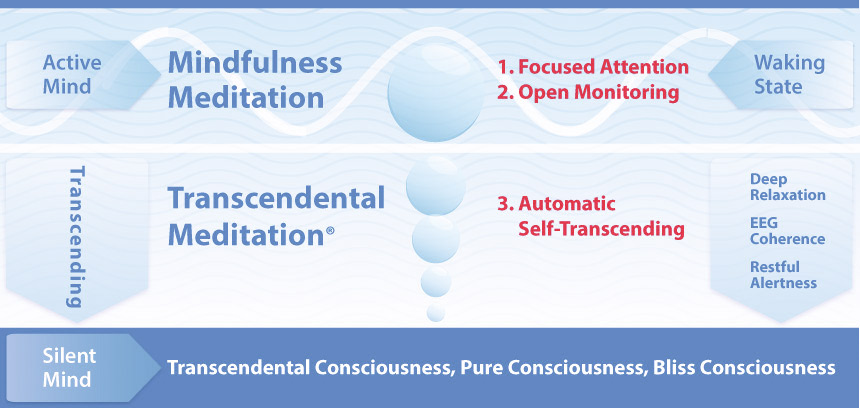
Three Types of Meditation: Focused Attention and Open Monitoring operate at the level of the active mind and require some degree of mental effort. In the TM technique, or Automatic Self-Transcending, the mind effortlessly and spontaneously settles down to quieter, subtler levels to experience the silent mind, Transcendental Consciousness.
We are interested in implementing the TM technique for staff and patients at our VA hospital. However, some of our staff are concerned that it is a religion.
The TM technique is not a religion. It is not based on belief or prayer, laws or morality, how one lives one’s life, or the dos and don’ts of life. The practice is based on a systematic, reliable, repeatable, and scientific procedure that produces measurable effects, regardless of one’s belief or faith.
Evidence shows that the TM technique lowers blood pressure, decreases inflammatory markers, decreases hospitalization rates, and even positively modifies the epigenome. Do you see a benefit in implementing the TM technique within a medical residency program?
Absolutely. For example, physician burnout is a critical problem in the medical field today. The TM technique increases resiliency in the physiology in many ways, which can help prevent burnout. One can only give from what one has. If the physician is tired, stressed, and strained, that will be reflected in their ability to treat their patients.
So the primary responsibility of a physician is to be happy, healthy, strong, and alert, so that they are able to perform their role successfully and without mistakes. Recent research has shown significant improvements in measures of insomnia, emotional exhaustion, and anxiety among healthcare professionals practicing the TM technique.
The primary responsibility of a physician is to be happy, healthy, strong, and alert, so that they are able to perform their role successfully and without mistakes.
In my TM practice, I feel more firmly rooted in my self, and yet also beyond my self. What happens to the self during meditation, and is that really me? And what changes can we expect to our self as we continue our practice of TM?
We normally identify our self with things like our nationality, appearance, name, profession, role in life, and so on. We think, “This is who I am.” But this is just one aspect of our self, the surface aspect. The true self is deep within us. We have heard the traditional wisdom to “Know thy self.” The fundamental meaning of that expression is to know who we truly are, which is the deepest level of Being within ourself that is beyond the surface values of our role, appearance, gender, race, and other characteristics.
The state of enlightenment is one in which we come to know that our consciousness is the consciousness of everything, and is the platform from which all life emerges. That consciousness is the undifferentiated source that nourishes and maintains all the specific values on the surface of our life.
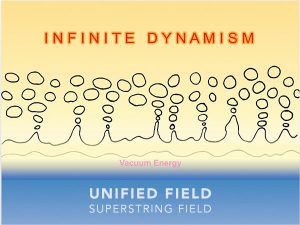
Modern science recognizes the existence of a unified field at the basis of everything
Modern science has verified to a great degree that all the outer expressions and forces of life, from physical structure to chemistry to the atomic and nuclear levels, are all expressions of one unified field of natural law. This field is ultimately a field of consciousness.
Through our regular TM practice, we go deep into that field of consciousness, our own Self, and then engage in our daily activity. In time, that inner value of the unbounded Self becomes established in our awareness, even in the midst of activity.
The true self is deep within us.
The patient is always at the center of our medical practice. Do you think implementing the Transcendental Meditation program for patients could be done on a larger scale once they are identified with cardiovascular risk factors, in order to prevent further progression of their disease?
Absolutely, and this is what we’re working towards, based on the scientific research, which shows reduced hospitalization rates, decreased cardiovascular disease, strengthening of the immuse system, and improvements in many other areas of health. TM is a simple, easy practice that anyone can do on their own, and that has no side effects.
All other modalities of treatment are important as well, but let us give the individual the best chance to respond to these other treatments from the basis of a stronger and more integrated physiology, for the best healing and fastest recovery possible.
What are the practical benefits for medical professionals of practicing the TM technique over many years?
The benefits of TM practice are cumulative. If we continue this daily hygiene of the mind and body that TM provides, the physiology and the mind will have less wear and tear, which contribute to aging and other health problems. Then we can offer maximum to others, because we are being the maximum within our own life.
The physician is also her own patient, so she has to take care of herself, too. An enlightened physician can give the best care to the patients in her practice.
The benefits of TM practice are cumulative.
How can we reconcile the differences between modern Western medicine and the traditional forms of healthcare that are practiced in many cultures? And how does meditation fit in with this?
I think the medical profession is realizing the importance of the basic things in life. For a long time, Western medicine has been a disease-oriented practice. This is a helpful approach in many ways, but it fails in other ways, such as the high costs associated with disease care. Now all the top universities are looking at prevention-oriented medicine to address these issues.
What is prevention-oriented medicine? It can include things like proper exercise, yoga, balanced diet, weight control, and other healthy activities. These approaches are already widely recognized and available in our culture.
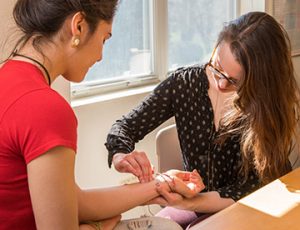
MIU students practice Maharishi AyurVeda® pulse assessment
Maharishi International University (MIU) in Fairfield, Iowa, has a fantastic program in integrated medicine with top researchers and scientists who are teaching these approaches. It’s a complete, natural system of prevention and healing for mind and body, creating wholeness of life, that can transform medicine to be truly a health profession, and not just a disease-oriented profession.
Preventing health problems before they arise is a much less costly way to improve the quality of life and well-being of the whole population than our current system of care.
It’s all coming together now, modern science with ancient knowledge and technologies, in an evidence-based approach to healthcare.
Watch Dr. Nader’s Q&A with medical students (55:27)
Maharishi International University (MIU) offers a complete, natural system of prevention and healing for mind and body, creating wholeness of life, that can transform medicine to be truly a health profession, and not just a disease-oriented profession.
Find additional talks by Dr. Nader on his Facebook page ►
To listen to Dr. Nader’s podcasts, find him on iTunes, Spotify, and SoundCloud, as well as Google Play, Cashbox, and all other podcast platforms.

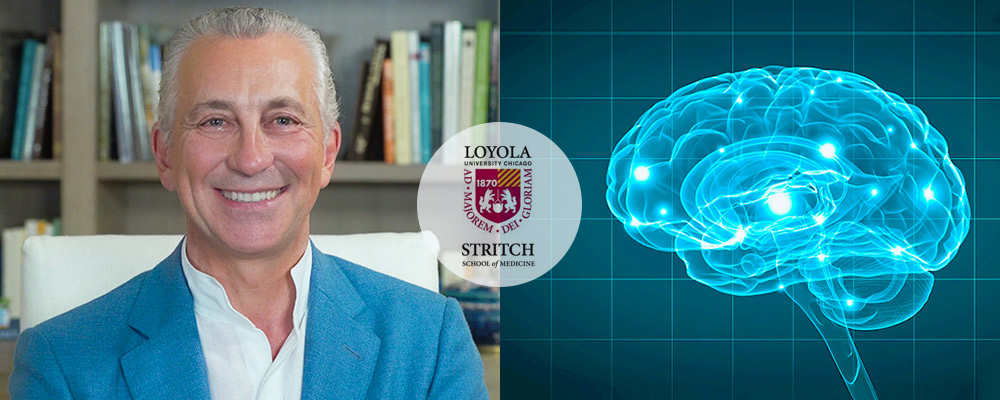
I am a TM meditator since 1975 and TM-Sidhi practitioner (occasional, not regular) since 1983. I can’t imagine life without TM and would urge all those who learn TM to be regular and derive its immense, cumulative benefit that comes about almost automatically. Effects of TM will still be felt when occasionally a meditator delays or omits a session, but I wouldn’t recommend it for any reason.
Excellent to read the transcript as I am hard of hearing, and listening to videos is less effective and more stressful than reading.
Glad to hear, Andrea! Although this isn’t a full transcript, we hoped that providing summaries of Dr. Nader’s answers would be helpful.